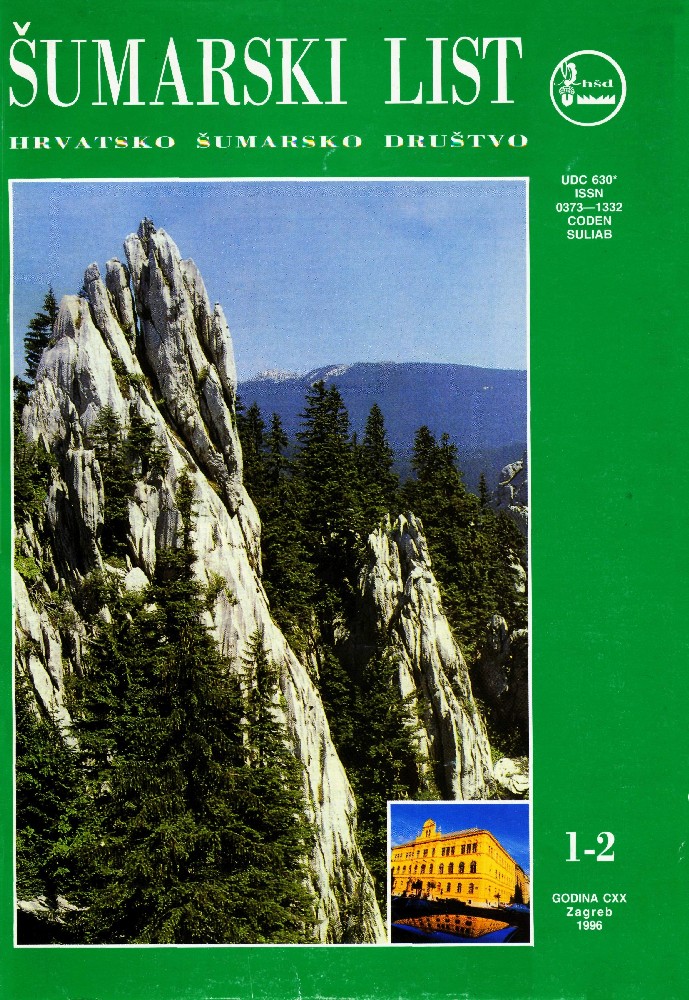
broj: 1-2/1996
pdf (19,4 MB) |
|
||||||||||||||
| IZVORNI ZNANSTVENI ČLANCI | ||
| Trinajstić, I. | UDK 630* 43+231.001 | |
| Succession of the Vegetation on Placea of Burned Holm oak and Black ash ass. Orno-Quercetum ilicis Forests in Croatia pdf HR EN | 3 | |
| Figurić, M. | UDK 630* 906.001 | |
| A Discussion on the Concept of Sustainable Management Influencing the Assessment of Forest Resource Value pdf HR EN | 9 | |
| PREGLEDNI ČLANCI | ||
| Tomašević, A. | UDK 630*421 | |
| Shelterbelts in the Sinj Plain pdf HR EN | 19 | |
| Rauš, Đ., Đuričić, I. | UDK 630*19:945.3 | |
| Educational Footpath on Kalnik pdf HR EN | 35 | |
| Jurković, M., Jurković-Bevilacqua, B. | UDK 630*232.322.5.(497.13) | |
| Mammoth tree - Sequoiadendron giganteum (Lindl.) Buchh. in Parks of Zagreb pdf HR EN | 47 | |
| Vondra, V., Blaszev, Z. | UDK 630*+90 | |
| Resystematization in Hungarian Forestry After the 1990. Social Changes pdf HR EN | 55 | |
| Summary: The development of Hungarian forestry is marked by two rather different periods. The first ended after World War I by the Trianona peace treaty, by which Hungary, due to earlier reductions, lost 84% of then most valuable forests (round 6.2 million ha). As a consequence of numerous unfavourable biotic and abiotic factors, forest health is continuously declining. The number of healthy trees dropped down to 35% in 1994. At all forestry education levels there are more students, technicians and engineers than needed in their professions. The resystematization of earlier state forest managements into joint-stock companies has not been the best long-term solution. The main interest of joint-stock companies is a maximization of forest exploitation revenues. Without an additional state regulative this could stimulate the earlier commenced reduction of biological forest reproduction investments. Owing to the general restructuring of Hungarian economy, the reapplication of the agricultural areas to forestlands has become a forced strategy of the national agriculture and forestry. If suitable stimulating economic measures were taken, the afforestation of new areas would engage one part of the currently unemployed forestry workers (800,000 in 1992). Governmentally supported through the expected foreign capital, the action would have the character of public works of a country in transition. The ownership rights are in Hungary represented by the Ministry of Finances. The joint-stock forestry management companies are represented by Joint-stock Company for Privatization and Management of National Property within the authority of Ministry of Privatization. Slow enforcement of forestry reorganization measures, the ineffective forest laws, and still uncleared ownership relations, all aggravate the prospects of sustainable forest management. Forest experts have already realized that the laws for unification of agricultural, forestry, hunting and environmental managements should be passed in "packages". Many processes have already started. With the presently available data it is impossible to estimate the effectivenesss of the Hungarian forest management resystematization. Key words: indices about forests; forest policy; forest laws; joint- stock company in forestry; strategies in Hungarian forestry; forest management resystematization | ||


